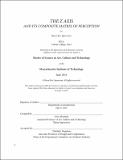| dc.contributor.advisor | Azra Aksamija. | en_US |
| dc.contributor.author | Sparrman, Bjorn Eric | en_US |
| dc.contributor.other | Massachusetts Institute of Technology. Department of Architecture. | en_US |
| dc.date.accessioned | 2017-01-12T18:18:07Z | |
| dc.date.available | 2017-01-12T18:18:07Z | |
| dc.date.issued | 2016 | en_US |
| dc.identifier.uri | http://hdl.handle.net/1721.1/106372 | |
| dc.description | Thesis: S.M. in Art, Culture and Technology, Massachusetts Institute of Technology, Department of Architecture, 2016. | en_US |
| dc.description | This electronic version was submitted by the student author. The certified thesis is available in the Institute Archives and Special Collections. | en_US |
| dc.description | "June 2016." Cataloged from student-submitted PDF version of thesis. | en_US |
| dc.description | Includes bibliographical references (pages 94-95). | en_US |
| dc.description.abstract | Beliefs and ideas mingle with our perceptions of physical objects and spaces as the same cognitive material. Within a conceptual mental space, these perceptions constitute a composite matrix of perception. When we navigate physical spaces, we are navigating ideas, and when we maneuver ideas we maneuver spaces. Ideologies form when the organization of this composite matrix crystallizes, refusing to adjust to new ideas or visual clues. This interplay between ideas and objects in space can lead to the formation of ideology. This thesis explores the ideological nature of navigable spaces and identifies two ways of escaping their ideological conditions: first, through the implementation of technical and conceptual devices, and second, through internal processes such as daydreaming and hypnosis. These two techniques often mingle. Various examples from art, film, and online communities are identified to demonstrate these techniques. The thesis will present video based experiments that test our perceptions in space by playing with the constructs of spatial mediation. These artistic experiments collectively form a vocabulary of techniques for probing the conceptual and physical dimensions of spaces. Throughout, this thesis aims to unpack the fundamental questions: can space exist without ideology, and if so, who can we be within this vacuum, unable to affect our surroundings? | en_US |
| dc.description.statementofresponsibility | by Bjorn Eric Sparrman. | en_US |
| dc.format.extent | 98 pages | en_US |
| dc.language.iso | eng | en_US |
| dc.publisher | Massachusetts Institute of Technology | en_US |
| dc.rights | M.I.T. theses are protected by copyright. They may be viewed from this source for any purpose, but reproduction or distribution in any format is prohibited without written permission. See provided URL for inquiries about permission. | en_US |
| dc.rights.uri | http://dspace.mit.edu/handle/1721.1/7582 | en_US |
| dc.subject | Architecture. | en_US |
| dc.title | The Z axis and its composite matrix of perception | en_US |
| dc.type | Thesis | en_US |
| dc.description.degree | S.M. in Art, Culture and Technology | en_US |
| dc.contributor.department | Massachusetts Institute of Technology. Department of Architecture | |
| dc.identifier.oclc | 967232914 | en_US |
